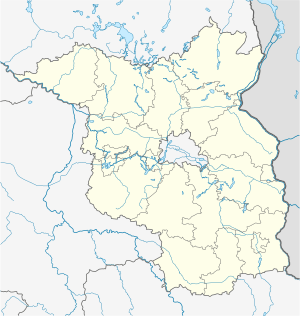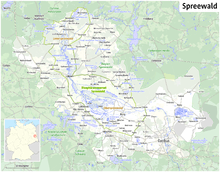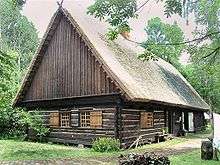Spreewald
The Spreewald (German for 'Spree Forest'; in Lower Sorbian: Błota, i.e. 'the Swamps') is a section of the German state of Brandenburg located about 100 km south-east of Berlin. It was the center of the Battle of Halbe at the end of World War II, which included the last major land conflicts between German and Soviet forces. Spreewald was designated a biosphere reserve by UNESCO in 1991. It is known for its traditional irrigation system, consisting of more than 200 small canals (called Fließe; total length: 1,300 kilometres or 810 miles) within the 484-square-kilometre (187 sq mi) area. The landscape was shaped during the last Ice Age.
| Spreewald | |
|---|---|
.jpg) The Spreewald Biosphere Reserve | |
 | |
| Location | Brandenburg |
| Coordinates | 51°54′50″N 13°55′35″E |
| Designated | Biosphere reserve |
| Website | Official website |

Overview

About 50,000 people live in the biosphere reserve (1998). Many of them are descendants of the first settlers in the Spreewald region, the Slavic tribes of the Sorbs and Wends. They have preserved their traditional language, customs and clothing to this day.
Most inhabitants depend on tourism. Many tourists explore the Spreewald in punts. Agriculture, forestry and fishery are other important sources of income. The principal town of the area is Lübbenau.
Spreewald gave its name to the following German districts:
Landscape and nature
Alder forests on wetlands and pine forests on sandy dry areas are characteristic of the Spreewald region. Grasslands and fields can be found as well. About 18,000 species of flora and fauna have been identified. In 1991, the Spreewald was designated a UNESCO "Biosphärenreservat" (Man and Biosphere Reserve Programme).
Economy
The Spreewald is a tourist destination, and a centre of production of natural organic products. The tourism and economic demarcation of the Spreewald is thus much more difficult than its geographical extension. Due to its popularity and the associated advantage, the borders of the Spreewald tourism and business area have increasingly extended beyond the original bounds of the Spreewald. This is particularly true of the regional food industry, as the Spreewald economic area created for this industry is much larger than the real Spreewald. This economic area is protected by the Protected Geographical Indication scheme of the EU.[1] Before the legal protection of the space there were several court disputes over the designation Spreewald on food labels.
See also
External links
| Wikimedia Commons has media related to Spreewald. |
| Wikivoyage has a travel guide for Spreewald. |
References
- Aladesuyi, Oluwakemi (2016-10-04). "Globalization: A Pickle's Tale". The Atlantic. Retrieved 2019-06-29.